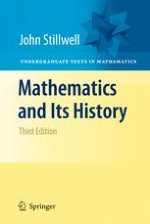2010 | OriginalPaper | Buchkapitel
Hypercomplex Numbers
Aktivieren Sie unsere intelligente Suche, um passende Fachinhalte oder Patente zu finden.
Wählen Sie Textabschnitte aus um mit Künstlicher Intelligenz passenden Patente zu finden. powered by
Markieren Sie Textabschnitte, um KI-gestützt weitere passende Inhalte zu finden. powered by
This chapter is the story of a generalization with an unexpected outcome. In trying to generalize the concept of real number to
n
dimensions, we find only four dimensions where the idea works:
n
= 1, 2, 4, 8. “Numberlike” behavior in ℝ
n
, far from being common, is a rare and interesting exception. Our idea of “numberlike” behavior is motivated by the cases
n
= 1, 2 that we already know: the real numbers ℝ and the complex numbers ℂ. The number systems ℝ and ℂ have both algebraic and geometric properties in common. The common algebraic property is that of being a
field
, and it is captured by nine laws governing addition and multiplication, such as
ab
=
ba
and
a
(
bc
) = (
ab
)
c
(commutative and associative laws for multiplication). The common geometric property is the existence of an
absolute value
, |
u
|, which measures the distance of
u
from
O
and is
multiplicative
: |
uv
| = |
u
||
v
|. In the 1830s and 1840s, Hamilton and Graves searched long and hard for “numberlike” behavior in ℝ
n
, but they came up short. Beyond ℝ and ℂ, only two
hypercomplex number
systems even come close: for
n
= 4 the
quaternion
algebra ℍ, which has all the required properties except commutative multiplication, and for
n
= 8 the
octonion
algebra
$$\mathbb{O}$$
, which has all the required properties except commutative and associative multiplication. Despite lacking some of the field properties, ℍ and
$$\mathbb{O}$$
can serve as coordinates for projective planes. In this setting, the missing field properties have a remarkable geometric meaning. Failure of the commutative law corresponds to failure of the Pappus theorem, and failure of the associative law corresponds to failure of the Desargues theorem.
